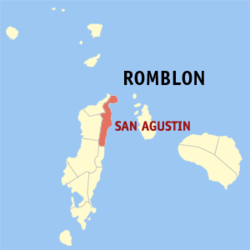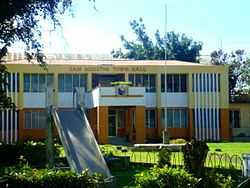San Agustin, Romblon
| San Agustin | ||
|---|---|---|
| Municipality | ||
|
Mount Payaopao | ||
| ||
 Map of Romblon with San Agustin highlighted | ||
.svg.png) San Agustin Location within the Philippines | ||
| Coordinates: 12°34′N 122°08′E / 12.567°N 122.133°ECoordinates: 12°34′N 122°08′E / 12.567°N 122.133°E | ||
| Country | Philippines | |
| Region | MIMAROPA (Region IV-B) | |
| Province | Romblon | |
| District | Lone district | |
| Founded | 1635 | |
| Barangays | 15 | |
| Government[1] | ||
| • Mayor | Emmanuel F. Madrona | |
| • Vice Mayor | Zaldy G. Marin | |
| • Councilors |
Yolly Burguete Norman Fatalla William Tan Claro Madrilejos, Jr. Carlos Catajay Lupo Manga Jimmy Morada Patria Perez | |
| Area[2] | ||
| • Total | 140.48 km2 (54.24 sq mi) | |
| Population (2010)[3] | ||
| • Total | 22,116 | |
| • Density | 160/km2 (410/sq mi) | |
| Time zone | PST (UTC+8) | |
| Zip Code | 5501 | |
| Dialing code | 42 | |
San Agustin (formerly Guintigui-an and Badajoz) is a fourth class municipality in the province of Romblon, Philippines.
History
San Agustin is known during Spanish times as Guintigui-an because of the abundance of a fish called "tigue" in the area. It was first inhabited by Negrito and Mangyan tribes from Panay and Mindoro, as well as migrants from island of Romblon, and southern Tablas.[4]
In the early part of Spanish conquest, the first settlement was at barangay Cabolutan. These early settlers found it not easy and indeed a sacrifice for them to cross the channel to Romblon town to attend their civil and religious duties. Thus the leaders of Cabolutan discussed the matter such as building a visita in their settlement of around 250 souls. Finally in 1635, the first church building made of coral stone and lime was started.
In 1700, the Spanish authorities decided to separate Cabolutan in Tablas Island from Romblon with its seat at visita Cabolutan subjugating all settlements west of Tablas Island. The new pueblo or town of Cabolutan continued to progress slowly and increased in population despite of frequent Moro raids. However, the town suffered an annihilation Smallpox epidemic which begun in 1790 that almost wiped-out its entire population. It resulted to a heavy toll of casualties that caused for the pueblo’s abolition that led to its incorporation back to Romblon until 1855 when another pueblo named Guintigui-an was founded some 4 kilometers south of the old town site. The town was founded by Don Laureano Montesa together with his brother Don Esteban and cousin Don Luis Montesa, who became Tiniente Absoluto in Romblon. Its jurisdiction included what is now the towns of Calatrava and Santa Maria. The construction of Cotta (Fort) at Payong-payong hill located at present day barangay Cagbo-aya started in 1873 which protected the community from Muslim pirates and still stands today. In 1868, the town was renamed "Badajoz" by a certain Spanish soldier named Andres Lebarde who happened to visit the town, after his native city of Badajoz, Spain.[4]
On 20 June 1957, by virtue of Republic Act No. 1660, the town's name of Badajoz was changed to San Agustin. after the town's patron saint.[5]
Geography
San Agustin is in the northeastern part of Tablas Island with a total land area of 14,048 hectares (34,710 acres). It is bounded on the north by the municipality of Calatrava, on the south by the municipality of Santa Maria, on the east by Romblon Pass facing the Romblon capital town and on the west by the municipality of San Andres. Its municipal port serves as the eastern gateway to the main island of Tablas, as well as to the neighboring islands of the province.
A mountain range shields the town from southeasterly monsoon but is completely and barely exposed to northeasterly typhoons. San Agustin has the second highest mountain in the province, the volcano-shaped Mount Payaopao at 2,182 feet (665 m) high, overlooking Carmen Bay.
Barangays
San Agustin is politically subdivided into 15 barangays:[6]
- Bachawan
- Binongaan
- Buli
- Cabolutan
- Cagboaya
- Camantaya
- Carmen
- Cawayan
- Doña Juana
- Dubduban
- Hinugusan
- Lusong
- Mahabangbaybay
- Poblacion
- Sugod
Demographics
According to the 2010 census, San Agustin has a population of 22,116 people.[3] Romblomanon or Ini is the native language of the municipality's inhabitants. Tagalog is widely understood, and English stands as the medium of communication in business and trade.
| Population census of San Agustin | ||
|---|---|---|
| Year | Pop. | ±% p.a. |
| 1960 | 18,373 | — |
| 1970 | 18,917 | +0.29% |
| 1980 | 21,664 | +1.37% |
| 1990 | 18,066 | −1.80% |
| 1995 | 20,160 | +2.08% |
| 2000 | 21,643 | +1.53% |
| 2007 | 22,118 | +0.30% |
| 2010 | 22,116 | −0.00% |
| Source: National Statistics Office[3] | ||
Local government

Pursuant to Chapter II, Title II, Book III of Republic Act 7160 or the Local Government Code of 1991,[7] the municipal government is composed of a mayor (alkalde), a vice-mayor (bise alkalde) and members (kagawad) of the legislative branch Sangguniang Bayan alongside a secretary to the said legislature, all of which are elected to a three-year term and are eligible to run for three consecutive terms.
The incumbent mayor and vice mayor of San Agustin for the term 2013–2016 are Emmanuel F. Madrona and Zaldy G. Marin, respectively.
Education
San Agustin has the following 15 public Elementary Schools:
- San Agustin Central School (Dubduban)
- Dayongdong Primary School (Dayongdong)
- Cawayan Elementary School (Cawayan)
- Long Beach Elementary School (Mahabangbaybay)
- Sugod Elementary School (Sugod)
- Carmen Elementary School (Carmen)
- Cabolutan Elementary School (Cabolutan)
- Luis M. Abello Sr. Primary School (Cagbo-aya)
- Doña Juana Elementary School (Doña Juana)
- Alfredo P. Navarette (Lubi) Elementary School (Binongaan)
- Severina M. Solidum Memorial Elementary School (Lusong)
- Hinugusan Elementary School (Hinugusan)
- Buli Elementary School (Buli)
- Camantaya Primary School (Camantaya)
- Bachawan Elementary School (Bachawan)
High Schools:
- Private:
- Holy Rosary Academy (Poblacion)
- Tablas Academy (Dubduban)
- Public:
- San Agustin National Trade High School (Mahabangbaybay)
- Carmen National High School (Carmen)
- Cabolutan National High School (Cabolutan)
- Eduardo M. Moreno National High School (Binongaan)
- Esteban M. Madrona Memorial National High School (Bachawan)
College / University:
- Private:
- Tablas College (Dubduban)
- Saint Augustine Institute of New Technology (Poblacion)
- Public: Romblon State University - San Agustin Campus (Cabolutan)
Health
San Agustin has its own hospital, the Tablas Island District Hospital, a government hospital, and four barangay health stations.
Economy
The municipality has various establishments including general merchandise stores, construction and welding shops, furniture outlets, funeral homes, rice mill, bake shops, bank, pawn shops, catering services, hostels, cable TV station, and Internet shops.
Farming and fishing provides the main source of livelihood for the residents in San Agustin. The farmers primary products are rice, coconut, banana, copra, abaca. Fishermen harvest the bounty of the surrounding seas. Aside from fishing, an alternative source of livelihood are swine and poultry raising, cottage industries such as raffia production (bags, baskets, mats, hats, etc.) rattan and nitto basket and plate weaving, broom production such as soft broom made of tiger grass, locally known as walis tambo, and coconut broom or broomstick made of coconut palm fronds (leaves), locally known as walis tingting.
Transportation
- By air
- From Manila, Zest Airways serves Tugdan Airport three times a week. Travel time from Manila Domestic Airport to Tugdan Airport is about an hour, and a less than an hour drive from Tugdan Airport to San Agustin.
- By water
- Access to San Agustin is usually by ferry from the port of Batangas City in southern Luzon and disembarking at the port of San Agustin or port of Odiongan in Barangay Poctoy. M/V Princess Annavel serves San Agustin from the port of Batangas City twice a week departing Batangas to San Agustin every Thursday and Saturday at 4:00 PM. Travel time from Batangas to San Agustin port takes about 8–10 hours. Travel time from San Agustin Pier to San Agustin town proper is about 1–2 minutes by motorcycles. Tricycles are also readily available. Meanwhile, Montenegro Lines serves Odiongan from the port of Batangas City daily with roll-on/roll-off vessels departing Batangas at 5:00 PM, with M/V Super Shuttle RORO departing Batangas to Odiongan every Tuesday, Thursday, and Saturday at 3:00 PM, and 2GO Travel departing Batangas to Odiongan every Sunday at 9:00 AM, and Monday, Tuesday and Friday at 9:00 PM. Travel time from Batangas to Odiongan port takes about 7–10 hours. A public utility jeep stationed in Odiongan port will bring you to San Agustin for a two hour drive.
- Getting around
- Public utility jeepneys, tricycles and motorcycles provide the main means of transport within the municipality, as well as to and from the neighbouring municipalities within Tablas Island. San Agustin has daily RORO ferry ( M/V Reina Magdalena / M/V Maria Querubin Montenegro Lines) and pump boat services to Romblon, Romblon and Magdiwang, Romblon. Pump boats leave San Agustin for Romblon, Romblon twice daily at 8:00 AM and 1:00 PM while RORO ferry ( M/V Reina Magdalena / M/V Maria Querubin of Montenegro Lines) leave San Agustin for Romblon, Romblon and Magdiwang, Romblon daily at 6:00 AM.
Communications
- Mobile Telephony and Internet
- Smart Communications, Globe Telecom, and Sun Cellular provides mobile phone and Internet services in San Agustin.
- Television/Cable
- The people of San Agustin is kept abreast of current events and information through broadcast media via television. At present, there are two free-to-air TV channels, GMA-7 and PTV-13, which both have established transmitter stations in the province. cable TV service is provided by a local cable TV operator, San Agustin Cable Corp., with areas covering the barangays of Poblacion, Dubduban, Cagboaya and Carmen. A subscription-based Direct-To-Home (DTH) satellite TV service provider is also made available in San Agustin by leading DTH service providers such as Dream Satellite TV, Cignal, and G Sat.
- Radio
- AM radio stations broadcasting from Manila and nearby provinces such as DZMM, DZBB, DZRH, Bombo Radio, RMN Network, etc. can be heard in San Agustin. Local FM radio station DWGM Charm Radio 100.5 FM (stationed in Romblon, Romblon) is also on-the-air daily broadcasting programs tailor made to the issues and needs of the local community.
- Print media
- Local newspapers being circulated in the municipality are the Pinoy Text, Romblon Sun, and Romblon Times. The local online magazine accessible from San Agustin is Romblon News.
- Postal Services
- The Philippine Postal Corporation provides postal services for the municipality with its post office in Barangay Poblacion.
Tourism
- Festivities: The people of San Agustin celebrates the Kalipayan Festival (Biniray / Streetdancing) held during the months of April and August while the Sabwagan Festival is held every month of February and July at Barangay Carmen.
- Attractions: San Agustin, among its attractions, include beaches, waterfalls, diving site, etc.
- Dubduban - Bita Falls, located in the interior of Barangay Dubduban, this impressive seven-tiered falls lies amidst dense vegetation and cool surroundings. The first tier is on the top of a hill with a 70-foot deep pool of clear blue-green waters. The bottom tier ends in a shallow pool of water.
- Long Beach, a long wide sandy beach located at the foot of Mt. Payaopao (Barangay Mahabangbaybay), now being developed as the center of eco-tourism in the municipality.
- Sunken Spanish Galleon (Barangay Carmen), this site is highly recommended for sea explorers. This Spanish Galleon can be found in the deep waters of Carmen Bay, ideal for scuba diving.
- Kambaye Beach (Barangay Binongaan), possess a white long sandy shore and provides a full view of Romblon Island.
- Trangkalan Grotto and Stations of the Cross, this sacred place can be found in Barangay Bachawan. The place offers a tranquil atmosphere for the religious and a cascading falls to refresh picnickers..
- Cawayan Park (Barangay Cawayan), the terrain is hilly and thickly forested, making it a homey refuge for wildlife flora and fauna.
- Punta Gorda Stairways (Barangay Cawayan), a concrete steps from the shoreline to the hilltop. Constructed by the national government in 1950, it is one of the most beautiful tourist spot in the area.
- Cotta (Barangay Cagboaya), the ruins of an old Spanish cotta or fort which was built by the natives to serve as a watch post for raiding Moro pirates. Perched on Payong-Payong Hill in Barangay Cagboaya, the remaining limestone walls of the cotta serve as a mute testimony to the town’s rich historic past.
- San Agustin Freedom Park (Barangay Poblacion), the municipal park in San Agustin is a sprawling hectare of greens by the bay. It offers an undisturbed view of ships passing through Romblon Pass and, on clear days, a view of the islands of Romblon and Sibuyan.
See also
- List of renamed cities and municipalities in the Philippines
References
- ↑ "Municipalities". Quezon City, Philippines: Department of the Interior and Local Government. Retrieved 31 January 2013.
- ↑ "Province: Romblon". PSGC Interactive. Makati City, Philippines: National Statistical Coordination Board. Retrieved 31 January 2013.
- ↑ 3.0 3.1 3.2 "Total Population by Province, City, Municipality and Barangay: as of May 1, 2010". 2010 Census of Population and Housing. National Statistics Office. Retrieved 31 January 2013.
- ↑ 4.0 4.1 Profile: San Agustin Romblon Travel Guide. Retrieved on 2012-04-16.
- ↑ "An Act Changing the Name of the Municipality of Badajoz, Province of Romblon, to San Agustin" LawPH.com Retrieved on 2011-04-12
- ↑ San Agustin: Barangays lakbayPinas.com Retrieved on 2012-04-16.
- ↑ "An Act Providing for a Local Government Code of 1991". 8th Congress of the Republic of the Philippines. Retrieved April 21, 2014.
External links
- Mancuyas, Mario M."San Agustin: Scenic Getaway Town of Tablas Island" Sanrokan.com Retrieved on 2012-04-16.
- About San Agustin Official Website of San Agustin, Romblon
- Philippine Standard Geographic Code
- Philippine Census Information
- Romblon News | Your #1 Source for Online News
 |
Sibuyan Sea |  | ||
| Calatrava San Andres |
|
Romblon Pass / Romblon | ||
| ||||
| | ||||
| Odiongan | Santa Maria |
| ||||||||||
